The global structural health monitoring (SHM) market is on the cusp of transformational growth, with its valuation expected to touch USD 4,478.0 million in 2024. This rapidly expanding industry is forecasted to grow at a compound annual growth rate (CAGR) of 14.0% from 2024 to 2034, exceeding a projected value of USD 16,601.1 million by 2034. The growing emphasis on infrastructure resilience, public safety, and longevity is propelling the demand for real-time health monitoring systems across sectors such as civil infrastructure, aerospace, energy, and defense.
Increasing investments in smart infrastructure, coupled with rising incidences of structural failures, are compelling governments and private entities to adopt robust SHM systems. Moreover, technological strides in sensor networks, data analytics, and cloud computing have enabled SHM systems to deliver accurate, predictive, and real-time diagnostic information-ensuring the structural integrity of critical assets.
Gain Access to Market Trends: Request Your Sample Report! https://www.futuremarketinsights.com/reports/sample/rep-gb-1167
Market Trends Highlighted:
• Integration of AI and ML: Machine learning algorithms and artificial intelligence are increasingly being used for real-time anomaly detection and predictive maintenance.
• Digital Twin Technology: Adoption of digital twins is enabling simulation-based monitoring of structures in virtual environments.
• Wireless Sensing Systems: Shift from wired to wireless systems is gaining traction due to lower installation costs and scalability.
• Remote Monitoring Capabilities: Use of cloud platforms and IoT devices allows remote health monitoring, especially useful in remote or hazardous environments.
• Modular SHM Systems: Demand for modular and portable SHM tools is on the rise to enable easy deployment across various construction types.
Recent Developments:
• Smart Infrastructure Projects: Many countries are deploying SHM systems in smart city initiatives and mega infrastructure projects, especially for bridges, tunnels, and high-rise buildings.
• Public-Private Collaborations: Governments in North America, Europe, and Asia are actively forming partnerships with tech firms to upgrade national infrastructure using SHM.
• Material Innovations: Use of nanotechnology and fiber-optic sensors is enhancing the precision and durability of SHM systems.
• Regulatory Push: Mandatory inclusion of SHM in safety protocols for dams, railways, and power plants is becoming more widespread globally.
Download Report Summary (PDF): https://www.futuremarketinsights.com/reports/brochure/rep-gb-1167
Key Takeaways of the Report:
• The SHM market will grow from USD 4,478.0 million in 2024 to USD 16,601.1 million by 2034, expanding at a CAGR of 14.0%.
• Infrastructure safety and predictive maintenance remain the key driving forces behind market growth.
• Civil infrastructure segment will dominate the market share due to increasing investments in transportation and public safety infrastructure.
• Wireless SHM systems are expected to outpace wired systems during the forecast period due to easier integration and scalability.
• North America is likely to maintain a strong market position, with Asia Pacific emerging as the fastest-growing region.
Market Drivers:
• Aging Infrastructure: Worldwide aging of bridges, buildings, and tunnels is increasing the demand for reliable SHM systems.
• Natural Disasters and Climate Change: Rising incidents of earthquakes, floods, and temperature stress necessitate continuous monitoring of structural integrity.
• Urbanization and Mega Projects: Rapid urban growth and development of smart cities are driving investment in SHM technology.
• Technological Advancements: Innovation in wireless sensor networks, AI analytics, and data processing tools enhance SHM capabilities.
• Regulatory Compliance: Implementation of stricter safety standards by international bodies and national governments mandates the deployment of SHM systems in critical infrastructure.
Regional Insights:
• North America: Expected to remain a market leader due to early adoption of smart technologies, aging infrastructure, and stringent regulatory frameworks in the U.S. and Canada.
• Europe: Strong presence of infrastructure rehabilitation programs, particularly in Germany, France, and the UK. EU-funded projects promoting smart transport and energy infrastructure bolster market growth.
• Asia-Pacific: Anticipated to be the fastest-growing regional market. Rapid urban development, particularly in China and India, is driving demand for SHM systems in roads, buildings, and railways.
• Middle East & Africa: Growing investments in oil & gas and urban infrastructure, especially in the UAE and South Africa, are opening new opportunities for market players.
• Latin America: Countries like Brazil and Mexico are investing in transportation infrastructure, albeit at a slower pace due to economic constraints.
Country-wise CAGR Analysis (2024-2034):
• India: CAGR of 16.2%, driven by Smart Cities Mission and large-scale infrastructure modernization.
• China: CAGR of 15.8%, backed by high-speed rail networks, urban housing, and mega bridge projects.
• United States: CAGR of 13.2%, due to federal infrastructure stimulus and highway/bridge upgrades.
• Germany: CAGR of 12.6%, supported by strong civil engineering R&D and EU mandates.
• Japan: CAGR of 11.9%, driven by aging infrastructure and earthquake-prone environments requiring resilient systems.
Competition Outlook:
The SHM market is moderately consolidated, with key players focusing on innovation, partnerships, and geographic expansion.
Key Strategic Moves:
• M&A Activity: Companies are engaging in mergers and acquisitions to expand technical capabilities and market reach.
• Product Launches: Emphasis on launching AI-powered, plug-and-play SHM platforms for end-users with minimal setup.
• Collaborations: Partnerships with infrastructure developers and city governments for long-term SHM implementation in smart city projects.
• R&D Investments: Heavy investments in R&D to improve the accuracy, lifespan, and connectivity of SHM devices.
Key Companies in the Market
• Nova Metrix LLC
• Campbell Scientific, Inc.
• COWI
• Geocomp Corporation
• Acellent Technologies, Inc.
• Sixense
• Pure Technologies (Xylem, Inc.)
• Digitex
• SGS SA
• Kinematics
• GEOKON
• National Instruments Corporation
• Livehooah
• SignaGuard
Key Segments in the Global Structural Health Monitoring Market
By Component:
• Hardware
o Sensors
o Data Acquisition Systems
• Software
o Design and Analysis
o Parameter Identification and Tracking
• Service
o Installation Service
o Design and Consulting Service
o Operation and Maintenance Service
By Type:
• Wired Systems
• Wireless Systems
By Application:
• Bridges and Dams
• Buildings and Stadiums
• Vessels and Platforms
• Airframes and Wind Turbines
• Large Machines and Equipment
By Region:
• North America
• Latin America
• Europe
• Asia Pacific
• MEA
Buy Now: https://www.futuremarketinsights.com/checkout/1167
Contact Us:
Future Market Insights Inc.
Christiana Corporate, 200 Continental Drive,
Suite 401, Newark, Delaware – 19713, USA
T: +1-347-918-3531
For Sales Enquiries: sales@futuremarketinsights.com
Website: https://www.futuremarketinsights.com
LinkedIn| Twitter| Blogs | YouTube
About Future Market Insights (FMI)
Future Market Insights, Inc. (ESOMAR certified, recipient of the Stevie Award, and a member of the Greater New York Chamber of Commerce) offers profound insights into the driving factors that are boosting demand in the market. FMI stands as the leading global provider of market intelligence, advisory services, consulting, and events for the Packaging, Food and Beverage, Consumer Technology, Healthcare, Industrial, and Chemicals markets. With a vast team of over 400 analysts worldwide, FMI provides global, regional, and local expertise on diverse domains and industry trends across more than 110 countries. Join us as we commemorate 10 years of delivering trusted market insights. Reflecting on a decade of achievements, we continue to lead with integrity, innovation, and expertise.
This release was published on openPR.
















